View in other NatureServe Network Field Guides
NatureServe
Montana
Utah
Wyoming
Idaho
Wisconsin
British Columbia
South Carolina
Yukon
California
New York
Toothcup - Rotala ramosior
State Rank Reason (see State Rank above)
Rare in Montana, where it is known from approximately a half-dozen wetland sites in the valley bottoms in the western portion of the state. Potential threats and impacts to the known occurrences, as well as population trends, need to be evaluated.
General Description
Toothcup is a small, glabrous annual with simple or branched, erect to prostrate stems that are up to 10 cm high. The opposite, narrowly lance-shaped leaves have short petioles and are 15-30 mm long. The tiny, solitary flowers are sessile in the axils of upper leaves. The cup-shaped, shallowly 4-lobed calyx is 1-3 mm long in flower but up to 4 mm long in fruit. The 4 stamens are shorter than the 1 mm long, white petals. The fruit is a globose capsule that is ca. 3 mm across.
Phenology
Flowering in late July-August.
Diagnostic Characteristics
Ammannia robusta has sessile, clasping leaf bases. Members of the genus Gratiola (Plantaginaceae) have short-stalked flowers and separate sepals. A hand lens will be necessary to discern the flower characters.
Species Range
Montana Range
Range Descriptions
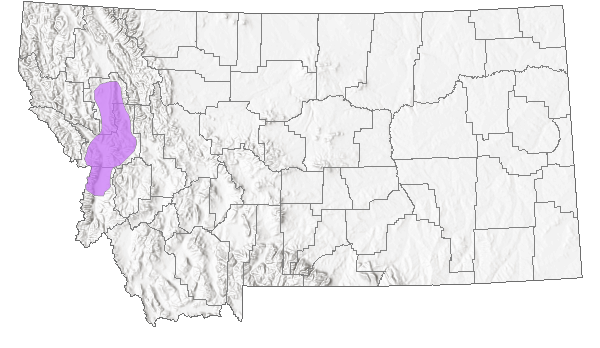
 Native
Native
Range Comments
Throughout U.S. south to S. America (Lesica et al. 2012. Manual of Montana Vascular Plants. BRIT Press. Fort Worth, TX).
Observations in Montana Natural Heritage Program Database
Number of Observations: 41
(Click on the following maps and charts to see full sized version)
Map Help and Descriptions
Relative Density
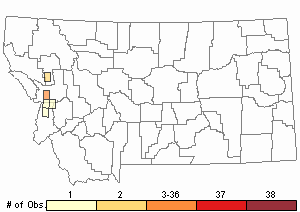
Recency
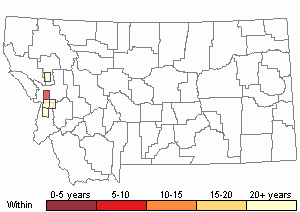
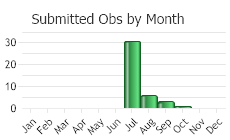
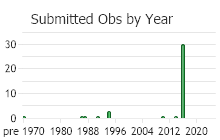
 (Observations spanning multiple months or years are excluded from time charts)
(Observations spanning multiple months or years are excluded from time charts)
Habitat
Open, wet, gravelly soil around ponds and sloughs in the valley zone.
National Vegetation Classification System Groups Associated with this Species
Wetland and Riparian
Riparian and Wetland Forest
Riparian Shrubland
Wet Meadow and Marsh
Stewardship Responsibility
Threats or Limiting Factors
STATE THREAT SCORE REASON
Threat impact not assigned because threats are not known (MTNHP Threat Assessment 2021).
References
- Literature Cited AboveLegend:
 View Online Publication
View Online Publication Hitchcock, C. L., A. Cronquist, M. Ownbey, and J. W. Thompson. 1961. Vascular Plants of the Pacific Northwest, Part 3. Saxifragaceae to Ericaceae. Seattle, WA and London, England: University of Washington. 614 pp.
Hitchcock, C. L., A. Cronquist, M. Ownbey, and J. W. Thompson. 1961. Vascular Plants of the Pacific Northwest, Part 3. Saxifragaceae to Ericaceae. Seattle, WA and London, England: University of Washington. 614 pp. Lesica, P., M.T. Lavin, and P.F. Stickney. 2012. Manual of Montana Vascular Plants. Fort Worth, TX: BRIT Press. viii + 771 p.
Lesica, P., M.T. Lavin, and P.F. Stickney. 2012. Manual of Montana Vascular Plants. Fort Worth, TX: BRIT Press. viii + 771 p. MTNHP Threat Assessment. 2021. State Threat Score Assignment and Assessment of Reported Threats from 2006 to 2021 for State-listed Vascular Plants. Botany Program, Montana Natural Heritage Program, Helena, Montana.
MTNHP Threat Assessment. 2021. State Threat Score Assignment and Assessment of Reported Threats from 2006 to 2021 for State-listed Vascular Plants. Botany Program, Montana Natural Heritage Program, Helena, Montana.
- Additional ReferencesLegend:
 View Online Publication
View Online Publication
Do you know of a citation we're missing? Cook, C.D.K. 1979. A revision of the genus Rotala (Lythraceae). Boissiera 29:1-?.
Cook, C.D.K. 1979. A revision of the genus Rotala (Lythraceae). Boissiera 29:1-?. Fassett, N. C. 1985. (3rd ed.) A Manual of Aquatic Plants, with Revision Appendix by E. C. Ogden. University of Wisconsin Press, Madison. 405 pp.
Fassett, N. C. 1985. (3rd ed.) A Manual of Aquatic Plants, with Revision Appendix by E. C. Ogden. University of Wisconsin Press, Madison. 405 pp. Lesica, P., M.T. Lavin, and P.F. Stickney. 2022. Manual of Montana Vascular Plants, Second Edition. Fort Worth, TX: BRIT Press. viii + 779 p.
Lesica, P., M.T. Lavin, and P.F. Stickney. 2022. Manual of Montana Vascular Plants, Second Edition. Fort Worth, TX: BRIT Press. viii + 779 p.
- Web Search Engines for Articles on "Toothcup"





